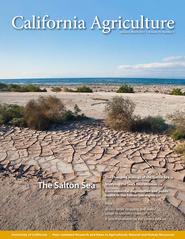All Issues

While the Salton Sea was a relatively stable ecosystem for most of the 20th century, recent agricultural-to-urban water transfers have caused significant impacts on the region’s ecology. This special issue of California Agriculture features review articles that highlight what recent research can say about the changing Salton Sea ecosystem and its environmental and human health–related impacts, and identify areas in which further scientific research is needed to better inform policy. Photo: Richard Trible, Istockphoto.com
Volume 76, Number 1





